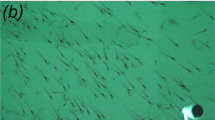Synopsis
The behavioral responses of common shiners (Notropis cornutus) to ‘Schreckstoff’ (alarm pheromone produced in the epidermis) were quantified in laboratory experiments. Schreckstoff increased cohesion and polarization, and decreased the variability in overall school dimensions. There was also a positive correlation between size of fish and their distance to the center of the school. Furthermore, the tendency to seek cover increased in the presence of Schreckstoff. The greater organization in school structure appears to be an adaptive response to aquatic predators, whereas increased cover seeking may be an adaptive response to aerial predators.
Similar content being viewed by others
References cited
Aoki, I. & T. Kuroki. 1975. Alarm reaction of three Japanese cyprinid fishes,Tribolodon hakonensis, Gnathopogon elongatus elongatus, Rhodeus ocellatus ocellatus. Bull. Jap. Soc. Sci. Fish. 41: 507–513.
Edmunds, M. 1974: Defence in animals. Longman, Harlow. 357 pp.
Frish, K. von. 1938. Zur Psychologie des Fish-Schwarmes. Die Naturwissenschaften 26: 601–606.
Frisch, K. von. 1941. Über einen Schreckstoff der Fischhaut and seine biologische Bedeutung. Z. vergl. Physiol. 29: 46–145.
Heczko, E. 1980. The effect of Schreckstoff on the behavior of the common shiner (Notropis cornutus, Cyprinidae). M.Sc. Thesis, University of Western Ontario, London. 67 pp.
Hobson, E.S. 1968. Predatory behavior of some inshore fishes in the Gulf of California. U.S. Bureau of Sport Fisheries and Wildlife. Research Report 73.
Keenleyside, M.H.A. 1955. Some aspects of the schooling behaviour of fish. Behaviour 8: 183–248.
Kushlan, J.A. 1978. Feeding ecology of wading birds. pp 249–297. In: A. Sprunt, J.C. Ogden, S. Winckler (ed.) Wading birds, Research Report # 7 of the National Audubon Society.
Marusov, Ye.A. 1976. Fright reaction in the predatory cyprinidOpsariichthys uncirostris amunsis. J. Ich. 16: 685–688.
Milinski, M. 1977. Experiments on the selection by predators against spatial oddity of their prey. Z. Tierpsychol. 43: 311–325.
Mueller, H.C. 1971. Oddity and specific search image more important than conspicuousness in prey selection. Nature 233: 345–346.
Pfeiffer, W. 1962. The fright reaction of fish. Biol. Rev. 37: 495–511.
Pfeiffer, W. 1963a. The fright reaction in North American fish. Can. J. Zool. 41: 69–77.
Pfeiffer, W. 1963b. Alarm substances. Experientia 19: 113–123.
Pfeiffer, W. 1975. Fluorescent pterins from the skin of Cypriniformes (Pisces) and their relation to the alarm pheromone. Rev. Suisse Zool. 82: 705–711.
Pfeiffer, W. 1977. The distribution of fright reaction and alarm substance cells in fishes. Copeia 1977: 653–665.
Pfeiffer, W. 1978. Heterocyclic compounds as releasers of the fright reaction in the giant danio,Danio malabaricus (Jerdon) (Cyprinidae, Ostariophysi, Pisces). J. Chem. Ecol. 4: 665–673.
Pfeiffer, W. & D. Lamour. 1976. The action of the alarm substance on the heart frequency ofPhoxinus phoxinus (Cyprinidae, Ostariophysi, Pisces). Rev. Suisse Zool. 83: 861–873.
Pfeiffer, W. & J. Lemke. 1973. Untersuchungen zur Isolierung and Identifizierung des Schreckstoffes aus der Haut der ElritzePhoxinus phoxinus (Cyprinidae, Ostariophysi, Pisces). J. Comp. Physiol. 82: 407–410.
Pfeiffer, W. & G. Riegelbauer. 1978. The effect of the alarm substance on the central nervous excitation of the black tetraGymnocorymbus ternetzi (Characidae, Ostariophysi, Pisces) indicated by dorsal light response. J. Comp. Physiol. 123: 281–288.
Salyer, J.C. & K.F. Lagler. 1940. The food habits of the American merganser during winter in Michigan, considered in relation to fish management. J. Wildl. Manage. 4: 189–219.
Salyer, J.C. & K.F. Lagler. 1946. The eastern belted kingfisherMegaceryle alcyon alcyon (Linnaeus), in relation to fish management. Trans. Amer. Fish. Soc. 76: 97–117.
Seghers, B.H. 1974. Schooling behavior in the guppy (Poecilia reticulata): an evolutionary response to predation. Evol. 28: 486–489.
Shaw, E. 1978. Schooling fishes. Amer. Sci 66: 166–175.
Smith, R.J.F. 1977. Chemical communication as adaptation: alarm substance of fish. pp. 303–320. In: D. Müller-Schwarze & M.M. Mozell (ed.) Chemical Signals in Vertebrates, Plenum Press, New York.
Thines, G. & E. Vandenbussche. 1966. The effects of alarm substance on the schooling behavior ofRasbora heteromorpha Duncker in day and night conditions. Anim. Behav. 14: 296–302.
Van Olst, J.C. & J.R. Hunter. 1970. Some aspects of the organization of fish schools. J. Fish. Res. Board Can. 27: 1225–1238.
Verheijen, F.J. 1956. Transmission of a flight reaction amongst a school of fish and the underlying sensory mechanisms. Experientia 12: 202–204.
Verheijen, F.J. 1962a. Gas spitting by alarmed fish disturbs their hydrostatic equilibrium. Science 137: 864–865.
Verheijen, F.J. 1962b. Alarm substance and intraspecific predation in cyprinids. Die Naturwissenschaften 49: 356.
Verheijen, F.J. 1963. Alarm substances in some North American cyprinid fish. Copeia 1963: 174–175.
Verheijen, F.J. & J.H. Reuter. 1969. The effect of alarm substance on predation among cyprinids Anim. Behav. 17: 551–554.
Williams, G.C. 1964. Measurement of consociation among fishes and comments on the evolution of schooling. Publ. Mus. Mich. State Univ. Biol. Series 2: 349–384.
Author information
Authors and Affiliations
Rights and permissions
About this article
Cite this article
Heczko, E.J., Seghers, B.H. Effects of alarm substance on schooling in the common shiner (Notropis cornutus, Cyprinidae). Environ Biol Fish 6, 25–29 (1981). https://doi.org/10.1007/BF00001796
Received:
Accepted:
Issue Date:
DOI: https://doi.org/10.1007/BF00001796




